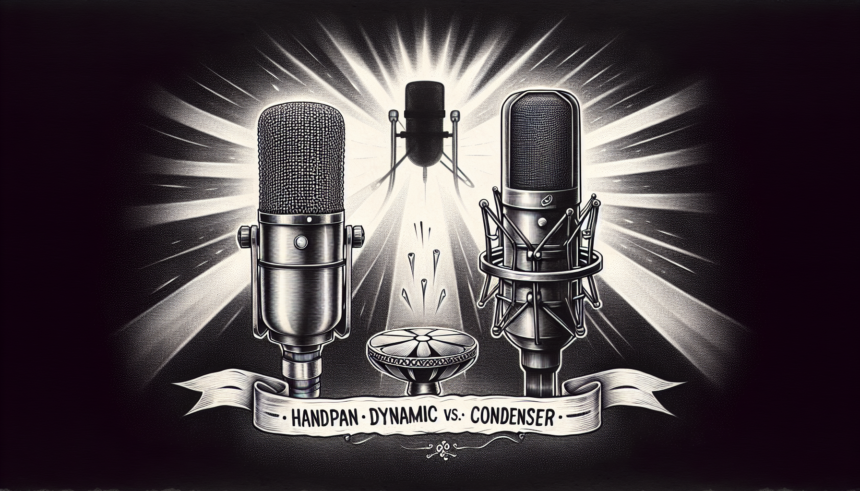<!DOCTYPE html>
<html lang="en">
<head>
<meta charset="UTF-8">
<meta name="viewport" content="width=device-width, initial-scale=1.0">
<title>Handpan Microphone Showdown: Dynamic vs. Condenser Mics</title>
</head>
<body>
<article>
<h1>Handpan Microphone Showdown: Dynamic vs. Condenser Mics</h1>
<p>The handpan, renowned for its ethereal, resonant properties, demands a microphone that can truly capture its unique sound. When seeking the perfect microphone for handpan recording or live performance, musicians typically narrow their choices between dynamic and condenser mics. Understanding the technical differences and practical applications of these two types can help you make the best choice for your needs.</p>
<h2>Understanding Dynamic Microphones</h2>
<p>Dynamic microphones operate using a simple yet robust mechanism. They contain a diaphragm attached to a coil of wire, situated in the magnetic field of a magnet. When sound waves hit the diaphragm, it moves the coil, generating an electrical current that mirrors the sound wave pattern. This type of microphone is known for its durability and ability to handle high sound pressure levels (SPL).</p>
<p>Dynamic microphones are generally less sensitive than their condenser counterparts. This makes them less prone to picking up ambient noise, a key advantage in live performance settings or noisy environments. They are also resilient to moisture and accidental drops, making them ideal for rigorous use on stage.</p>
<p>Popular dynamic microphones include the Shure SM57 and SM58, both of which are industry standards. They are highly regarded for their performance and reliability, particularly in live settings.</p>
<h3>Advantages of Dynamic Microphones</h3>
<ul>
<li><strong>Durability:</strong> With fewer delicate parts, dynamic mics can withstand rough handling.</li>
<li><strong>High SPL Handling:</strong> They can capture loud sounds without distortion, perfect for live performances.</li>
<li><strong>Noise Rejection:</strong> Less sensitive to ambient noise, making them useful in noisy environments.</li>
<li><strong>Cost-Effective:</strong> Generally more affordable than condenser microphones.</li>
</ul>
<h2>Exploring Condenser Microphones</h2>
<p>Condenser microphones function on a more delicate mechanism. They use a capacitor to convert acoustical energy into electrical energy. When sound waves hit the diaphragm, it moves in relation to a backplate, resulting in varying capacitance and hence an electrical signal. Due to their construction, they require an external power source, commonly supplied via phantom power (+48V) from a mixing console or audio interface.</p>
<p>Condenser microphones are highly sensitive and offer a higher-fidelity sound with greater detail and clarity. This sensitivity is ideal for studio recording where capturing the subtleties of a handpan's overtones and resonance is crucial. However, their sensitivity also means they pick up more ambient noise, which can be a disadvantage in less controlled environments.</p>
<p>Some well-regarded condenser microphones include the Audio-Technica AT2020 and the Neumann U87, both celebrated for their exceptional sound quality and precision.</p>
<h3>Advantages of Condenser Microphones</h3>
<ul>
<li><strong>High Sensitivity and Fidelity:</strong> Captures detailed, nuanced sound perfect for studio recordings.</li>
<li><strong>Wide Frequency Response:</strong> Can accurately capture the entire range of a handpan's sound.</li>
<li><strong>Greater Transient Response:</strong> Excellent at capturing fast, transient signals which are common in percussive instruments like the handpan.</li>
<li><strong>Phantom Power:</strong> Utilizing +48V phantom power ensures a consistent and strong signal.</li>
</ul>
<h2>Comparative Analysis for Handpan Recording</h2>
<p>When deciding between dynamic and condenser microphones for recording a handpan, it’s essential to consider the specific use-case scenarios and personal preferences in sound quality.</p>
<h3>1. Recording Environment</h3>
<p>If you have a dedicated, acoustically treated recording space, a condenser microphone will likely be the best choice. The sensitivity and fidelity will allow you to capture the full range of the handpan's sound, including the subtle overtones and resonances that give the instrument its characteristic depth.</p>
<p>Conversely, if you are recording in a less controlled environment, a dynamic microphone might be more forgiving. Its natural resilience to background noise can provide a cleaner recording without unwanted ambient sounds.</p>
<h3>2. Live Performance</h3>
<p>In live performance settings, dynamic microphones tend to shine. Their ability to handle high SPL without distortion, coupled with their durability, makes them a reliable choice. Additionally, their directional pickup patterns can help reduce feedback and unwanted noise from the surrounding environment.</p>
<p>That said, some performers might prefer the clarity and detail provided by a condenser mic during a live performance. If the stage environment is well-controlled and feedback is managed, a condenser mic can deliver an impressive live sound experience.</p>
<h3>3. Sound Preference</h3>
<p>Ultimately, some of the decision will come down to personal sound preference. Dynamic mics can deliver a warmer, punchier sound that some musicians might prefer for their handpan. Condenser mics, on the other hand, offer a more detailed and clear sound that accurately captures every nuance of the instrument.</p>
<h2>Conclusion</h2>
<p>Choosing between a dynamic and a condenser microphone for handpan recording or performance hinges on various factors, including recording environment, application needs, and personal sound preference. Dynamic microphones, with their durability and noise rejection, are ideal for live performances and less controlled recording environments. Condenser microphones, with their high sensitivity and accuracy, are best suited for studio recordings, where capturing the full spectrum of the handpan's sound is paramount.</p>
<p>Weighing these aspects carefully will help you make an informed decision, ensuring that the microphone you choose will deliver the sound quality and reliability you need for your musical endeavors.</p>
<h2>Frequently Asked Questions</h2>
<h3>1. Can I use both dynamic and condenser microphones simultaneously for recording a handpan?</h3>
<p>Yes, using both types of microphones can provide a versatile recording setup, capturing the handpan’s full range and detail while maintaining warmth and minimizing ambient noise. Combining the outputs can create a more balanced and full sound.</p>
<h3>2. Do I need any special equipment to use a condenser microphone?</h3>
<p>Condenser microphones require an external power source, typically supplied via phantom power (+48V). Most modern audio interfaces and mixing consoles provide this power. Additionally, ensure you have suitable acoustic treatment if recording in a home studio.</p>
<h3>3. Are there any specific microphone placement tips for recording a handpan?</h3>
<p>Yes, placement is crucial. Positioning the microphone around 12-18 inches above the handpan can capture a balanced sound. For a condenser mic, this distance typically ensures it picks up the complete tonal range. Adjusting the angle and distance based on the room acoustics and playing style can also help achieve the desired sound.</p>
<h3>4. How do I manage feedback when using condenser microphones in live settings?</h3>
<p>To manage feedback, use directional condenser microphones and place them off-axis from the speakers. Employing monitor speakers with higher directivity or using in-ear monitors can also reduce feedback. Additionally, employing a sound engineer to manage sound levels and EQ settings during the performance can help mitigate feedback issues.</p>
<h3>5. Are there any budget-friendly condenser microphones suitable for handpan recording?</h3>
<p>Yes, there are several budget-friendly options available. The Audio-Technica AT2020 and Rode NT1-A are popular choices that offer excellent sound quality at a reasonable price point. These microphones provide the critical sensitivity and fidelity needed to capture the nuances of a handpan without breaking the bank.</p>
</article>
</body>
</html>Handpan Microphone Showdown: Dynamic vs. Condenser Mics

Leave a comment




